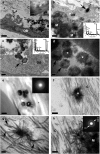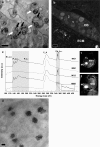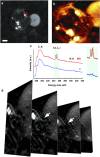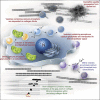The role of intracellular calcium phosphate in osteoblast-mediated bone apatite formation
- PMID: 22879397
- PMCID: PMC3435222
- DOI: 10.1073/pnas.1208916109
The role of intracellular calcium phosphate in osteoblast-mediated bone apatite formation
Abstract
Mineralization is a ubiquitous process in the animal kingdom and is fundamental to human development and health. Dysfunctional or aberrant mineralization leads to a variety of medical problems, and so an understanding of these processes is essential to their mitigation. Osteoblasts create the nano-composite structure of bone by secreting a collagenous extracellular matrix (ECM) on which apatite crystals subsequently form. However, despite their requisite function in building bone and decades of observations describing intracellular calcium phosphate, the precise role osteoblasts play in mediating bone apatite formation remains largely unknown. To better understand the relationship between intracellular and extracellular mineralization, we combined a sample-preparation method that simultaneously preserved mineral, ions, and ECM with nano-analytical electron microscopy techniques to examine osteoblasts in an in vitro model of bone formation. We identified calcium phosphate both within osteoblast mitochondrial granules and intracellular vesicles that transported material to the ECM. Moreover, we observed calcium-containing vesicles conjoining mitochondria, which also contained calcium, suggesting a storage and transport mechanism. Our observations further highlight the important relationship between intracellular calcium phosphate in osteoblasts and their role in mineralizing the ECM. These observations may have important implications in deciphering both how normal bone forms and in understanding pathological mineralization.
Conflict of interest statement
The authors declare no conflict of interest.
Figures




References
-
- Glimcher MJ. Recent studies of the mineral phase in bone and its possible linkage to the organic matrix by protein-bound phosphate bonds. Philos Trans R Soc Lond B Biol Sci. 1984;304:479–508. - PubMed
-
- Anderson HC. Molecular biology of matrix vesicles. Clin Orthop Relat Res. 1995;(314):266–280. - PubMed
-
- Boskey AL. Biomineralization: Conflicts, challenges, and opportunities. J Cell Biochem Suppl. 1998;30–31:83–91. - PubMed
Publication types
MeSH terms
Substances
Grants and funding
LinkOut - more resources
Full Text Sources
Other Literature Sources

